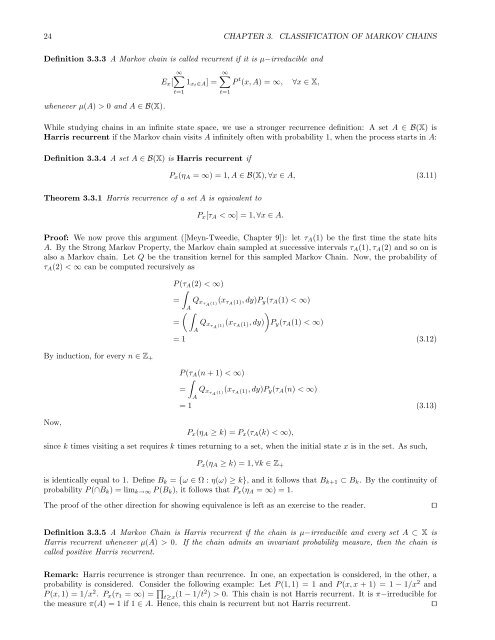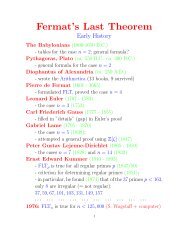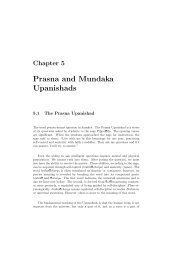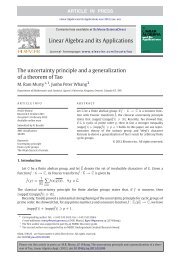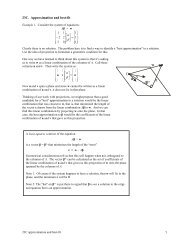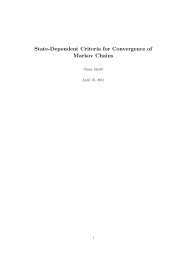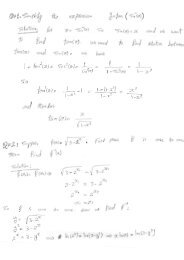Lecture Notes - Department of Mathematics and Statistics - Queen's ...
Lecture Notes - Department of Mathematics and Statistics - Queen's ...
Lecture Notes - Department of Mathematics and Statistics - Queen's ...
You also want an ePaper? Increase the reach of your titles
YUMPU automatically turns print PDFs into web optimized ePapers that Google loves.
24 CHAPTER 3. CLASSIFICATION OF MARKOV CHAINS<br />
Definition 3.3.3 A Markov chain is called recurrent if it is µ−irreducible <strong>and</strong><br />
whenever µ(A) > 0 <strong>and</strong> A ∈ B(X).<br />
∞∑<br />
∞∑<br />
E x [ 1 xt∈A] = P t (x, A) = ∞, ∀x ∈ X,<br />
t=1<br />
t=1<br />
While studying chains in an infinite state space, we use a stronger recurrence definition: A set A ∈ B(X) is<br />
Harris recurrent if the Markov chain visits A infinitely <strong>of</strong>ten with probability 1, when the process starts in A:<br />
Definition 3.3.4 A set A ∈ B(X) is Harris recurrent if<br />
P x (η A = ∞) = 1, A ∈ B(X), ∀x ∈ A, (3.11)<br />
Theorem 3.3.1 Harris recurrence <strong>of</strong> a set A is equivalent to<br />
P x [τ A < ∞] = 1, ∀x ∈ A.<br />
Pro<strong>of</strong>: We now prove this argument ([Meyn-Tweedie, Chapter 9]): let τ A (1) be the first time the state hits<br />
A. By the Strong Markov Property, the Markov chain sampled at successive intervals τ A (1), τ A (2) <strong>and</strong> so on is<br />
also a Markov chain. Let Q be the transition kernel for this sampled Markov Chain. Now, the probability <strong>of</strong><br />
τ A (2) < ∞ can be computed recursively as<br />
P(τ A (2) < ∞)<br />
∫<br />
= Q (x xτA (1) τ A(1), dy)P y (τ A (1) < ∞)<br />
A<br />
( ∫<br />
)<br />
= Q (x xτA (1) τ A(1), dy) P y (τ A (1) < ∞)<br />
A<br />
= 1 (3.12)<br />
By induction, for every n ∈ Z +<br />
P(τ A (n + 1) < ∞)<br />
∫<br />
= Q (x xτA (1) τ A(1), dy)P y (τ A (n) < ∞)<br />
Now,<br />
A<br />
= 1 (3.13)<br />
P x (η A ≥ k) = P x (τ A (k) < ∞),<br />
since k times visiting a set requires k times returning to a set, when the initial state x is in the set. As such,<br />
P x (η A ≥ k) = 1, ∀k ∈ Z +<br />
is identically equal to 1. Define B k = {ω ∈ Ω : η(ω) ≥ k}, <strong>and</strong> it follows that B k+1 ⊂ B k . By the continuity <strong>of</strong><br />
probability P(∩B k ) = lim k→∞ P(B k ), it follows that P x (η A = ∞) = 1.<br />
The pro<strong>of</strong> <strong>of</strong> the other direction for showing equivalence is left as an exercise to the reader.<br />
⊓⊔<br />
Definition 3.3.5 A Markov Chain is Harris recurrent if the chain is µ−irreducible <strong>and</strong> every set A ⊂ X is<br />
Harris recurrent whenever µ(A) > 0. If the chain admits an invariant probability measure, then the chain is<br />
called positive Harris recurrent.<br />
Remark: Harris recurrence is stronger than recurrence. In one, an expectation is considered, in the other, a<br />
probability is considered. Consider the following example: Let P(1, 1) = 1 <strong>and</strong> P(x, x + 1) = 1 − 1/x 2 <strong>and</strong><br />
P(x, 1) = 1/x 2 . P x (τ 1 = ∞) = ∏ t≥x (1 − 1/t2 ) > 0. This chain is not Harris recurrent. It is π−irreducible for<br />
the measure π(A) = 1 if 1 ∈ A. Hence, this chain is recurrent but not Harris recurrent.<br />
⊓⊔


